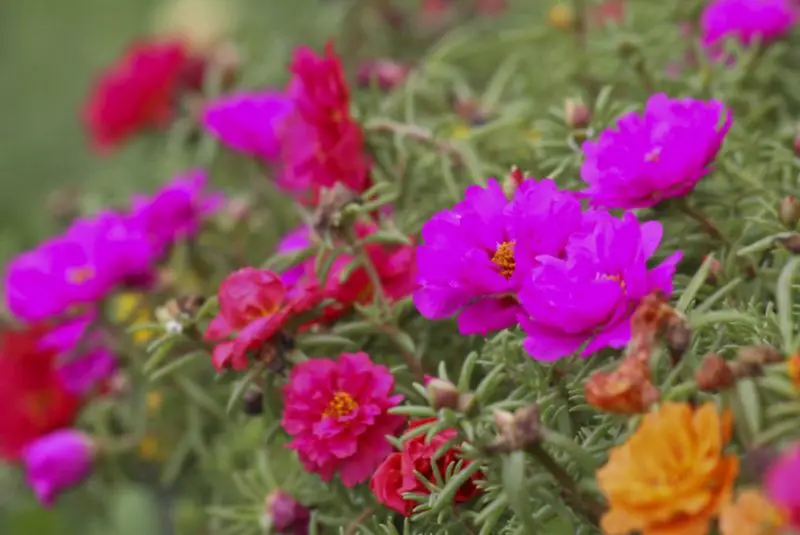Portulaca, commonly known as moss rose or purslane, is a vibrant, low-maintenance flowering plant that thrives in sunny conditions. Its dazzling blooms and succulent-like foliage make it a favorite choice for gardeners looking to add a splash of color to rock gardens, hanging baskets, or sunny borders.
In this guide, we will explore everything you need to know about caring for and growing Portulaca flowers, ensuring they flourish beautifully in your garden.
What Are Portulaca Flowers?

Portulaca, commonly referred to as moss rose or purslane, is a genus of flowering plants belonging to the Portulacaceae family. This diverse genus comprises over 100 species, predominantly native to South America, although some species are found in other warm, tropical regions around the world. These resilient plants are known for their vibrant, cheerful blooms and fleshy, needle-like leaves, making them well-suited to hot, dry climates. Their low-growing, spreading habit creates a lush, colorful ground cover that is both ornamental and functional in garden landscapes.
Historical Background and Cultural Significance
Portulaca has been cultivated for centuries, not only for its ornamental value but also for its medicinal and culinary uses. In ancient times, Portulaca oleracea (commonly known as purslane) was highly regarded for its nutritional value and was widely used as a leafy vegetable. Its succulent leaves are rich in omega-3 fatty acids, vitamins, and minerals. In traditional medicine, purslane was believed to have anti-inflammatory and diuretic properties.
The ornamental varieties, especially Portulaca grandiflora, were first cultivated in South America and later introduced to Europe in the 19th century. Their popularity quickly spread due to their dazzling blooms and ability to thrive in harsh, dry conditions. Today, Portulaca is cherished worldwide for its vibrant colors and low-maintenance nature.
Botanical Description and Growth Habit
Portulaca plants are typically low-growing, spreading annuals or short-lived perennials, depending on the climate. They are characterized by their fleshy, cylindrical, or needle-like leaves that help them retain moisture, making them highly drought-tolerant. The plants have a prostrate, mat-forming habit, which allows them to spread across the ground, creating a colorful, carpet-like display.
The stems of Portulaca are thin, reddish, and succulent, contributing to the plant’s water-storing capability. These stems grow close to the ground, often rooting at the nodes as they spread, which helps stabilize soil and prevent erosion, making them an excellent choice for slopes and rock gardens.
Portulaca flowers are cup-shaped with five petals, although some double-flowered varieties can have more. They are typically small, ranging from 1 to 2 inches in diameter, but their vivid colors make a bold impact. The blooms open in the morning when the sun is bright and close by evening, although some newer hybrids stay open longer, even on cloudy days.
Characteristics of Portulaca
Portulaca flowers are renowned for their brilliant, eye-catching colors, including shades of pink, red, yellow, orange, purple, and white. Some varieties even boast bi-colored blooms with striking patterns. The intense colors attract pollinators such as bees and butterflies, enhancing the biodiversity of your garden.
One of the most remarkable characteristics of Portulaca is its ability to thrive in poor, sandy soils where other plants struggle. Its succulent leaves store water efficiently, allowing it to survive prolonged periods of drought. This makes Portulaca an ideal choice for xeriscaping and rock gardens.
In addition to their beauty, Portulaca flowers are also self-cleaning, meaning they naturally drop spent blooms. This minimizes the need for deadheading and keeps the plants looking fresh throughout the growing season. The flowers are typically short-lived, but the plant continuously produces new blooms, ensuring a steady display of color from late spring to early fall.
Popular Varieties of Portulaca
There are several popular varieties of Portulaca, each with unique characteristics and growth habits. Understanding the differences can help you choose the best type for your garden design.
Portulaca grandiflora: This is the most commonly grown ornamental species, known for its large, showy blooms in vivid colors such as pink, red, yellow, orange, and white. It is often called moss rose due to its rose-like flowers and mossy foliage. Portulaca grandiflora is an annual that thrives in full sun and is perfect for borders, rock gardens, and containers.
Portulaca umbraticola: Unlike other varieties, Portulaca umbraticola has slightly smaller flowers and a more spreading habit, making it ideal for hanging baskets and ground cover. It is also more shade-tolerant compared to other species, although it still prefers bright light for abundant blooming. The flowers come in a variety of colors, including orange, yellow, and pink.
Portulaca oleracea: Commonly known as purslane, this variety is edible and often used in salads and culinary dishes. It has smaller, yellow flowers and a sprawling growth habit. The leaves are more rounded and succulent compared to ornamental varieties. Portulaca oleracea is valued not only for its ornamental appeal but also for its nutritional benefits, as it is rich in omega-3 fatty acids and antioxidants.
Portulaca ‘Sundial Series’: This hybrid series is known for its early blooming and semi-double flowers that stay open longer, even on cloudy days. The blooms come in a wide range of colors, including bicolors with contrasting centers. These hybrids are compact, making them ideal for container gardening.
Portulaca ‘Happy Hour Series’: Another popular hybrid series, known for its vibrant, large blooms and compact, mounding habit. It blooms earlier than traditional varieties and has a prolonged flowering season. This series is perfect for hanging baskets, borders, and rock gardens.
Why Choose Portulaca for Your Garden?
Portulaca is an excellent choice for gardeners seeking a low-maintenance, drought-resistant plant. It thrives in poor, sandy soils where other plants struggle. Its vibrant flowers attract pollinators like bees and butterflies, adding life to your garden. Additionally, its spreading habit makes it ideal for ground cover, preventing soil erosion and minimizing weed growth.
How to Plant Portulaca
Portulaca, known for its vibrant blooms and hardy nature, is a delightful addition to any garden. To ensure healthy growth and a stunning display of color, it is essential to understand the right planting time, location, soil preparation, and methods for sowing seeds or transplanting seedlings. In this section, we will provide a detailed guide on how to plant Portulaca successfully.
When to Plant Portulaca
Portulaca is a warm-season flowering plant that thrives in temperatures between 70°F to 85°F (21°C to 29°C). It is highly sensitive to frost, so timing your planting correctly is crucial for optimal growth and blooming.
Planting in Warmer Climates
In warmer climates (USDA Hardiness Zones 9-11), Portulaca can be planted as early as late spring when nighttime temperatures consistently stay above 60°F (15°C). In these regions, you can enjoy continuous blooming from late spring through fall, as Portulaca is well-suited to hot, dry conditions.
Planting in Cooler Regions
In cooler regions (USDA Zones 6-8), it is best to wait until early summer when the soil has warmed up sufficiently. The ideal time is usually 2-3 weeks after the last frost date. Planting too early in cold, damp soil can result in poor germination and stunted growth.
Indoor Seed Starting
For an early start, you can sow Portulaca seeds indoors 6-8 weeks before the last frost date. Use seed trays filled with a light, well-draining seed-starting mix. Since Portulaca seeds require light to germinate, scatter them on the soil surface and press them down gently without covering them. Place the trays in a warm, sunny location or under grow lights. Maintain a temperature of around 75°F (24°C) for optimal germination. Once the seedlings develop two sets of true leaves, they can be transplanted outdoors after hardening off.
Choosing the Right Location
Portulaca loves the sun and thrives in locations with full sun exposure. To ensure maximum blooming, choose a spot that receives at least 6-8 hours of direct sunlight daily. Insufficient sunlight can lead to sparse blooming and leggy growth.
Ideal Garden Locations for Portulaca
- Rock Gardens: Portulaca’s low-growing, spreading habit makes it perfect for rock gardens where it cascades beautifully over stones.
- Borders and Edging: Its compact, mat-forming growth makes it an excellent choice for borders, adding a vibrant splash of color along garden paths.
- Containers and Hanging Baskets: The trailing stems look stunning when cascading from containers or hanging baskets. Ensure good drainage to prevent waterlogging.
- Sunny Slopes: Portulaca is ideal for slopes and embankments, where its spreading growth helps control soil erosion.
Avoid Shady Areas and Poor Drainage
Avoid planting Portulaca in shaded areas or locations with less than 6 hours of sunlight, as it may result in poor flowering and leggy growth. Additionally, avoid heavy clay soils or areas prone to waterlogging, as Portulaca is susceptible to root rot in poorly drained soils.
Preparing the Soil
Portulaca is remarkably adaptable and thrives in poor, sandy soils. It prefers well-draining soil with a slightly acidic to neutral pH range of 5.5 to 7.0. The most critical factor is ensuring proper drainage, as overly wet soil can cause root rot and other fungal diseases.
Steps to Prepare the Soil for Portulaca
- Loosen the Soil: Begin by loosening the top 6 inches of soil using a garden fork or tiller. This improves aeration and root penetration.
- Amend with Sand or Perlite: Mix in coarse sand or perlite to enhance drainage, especially if your soil is heavy or clayey. A ratio of 1 part sand to 3 parts garden soil works well.
- Avoid Rich Compost or Fertilizers: Portulaca thrives in lean soil. Adding rich compost or fertilizers can lead to lush foliage at the expense of blooms.
- Level the Soil Surface: Rake the soil to create a smooth, even surface for planting.
Planting Portulaca Seeds or Seedlings
Portulaca can be easily grown from seeds or by transplanting seedlings. Each method has its advantages depending on your gardening preferences and local climate.
Growing Portulaca from Seeds
Growing Portulaca from seeds is an economical and straightforward method. However, patience is required, as the tiny seeds need optimal conditions for germination.
Direct Sowing Outdoors
- Timing: Sow seeds directly outdoors once the soil has warmed to at least 70°F (21°C) and there is no risk of frost.
- Sowing Method: Scatter the tiny seeds evenly over the soil surface. Since they require light to germinate, do not cover them with soil. Instead, press them down gently to ensure good contact with the soil.
- Watering: Lightly mist the soil with a fine spray to avoid displacing the seeds. Keep the soil consistently moist until germination occurs, typically within 7-14 days.
- Spacing: Once the seedlings have two sets of true leaves, thin them to about 6-8 inches apart to allow room for spreading.
Indoor Seed Starting
- Containers: Use shallow seed trays or small pots filled with a light, well-draining seed-starting mix.
- Light Requirements: Place the trays in a bright, sunny window or under grow lights for at least 12-14 hours daily.
- Transplanting: Harden off the seedlings by gradually exposing them to outdoor conditions over 7-10 days before transplanting.
Transplanting Portulaca Seedlings
If you prefer faster results, you can buy Portulaca seedlings from nurseries or start your own indoors. Transplanting is relatively easy, but care should be taken to avoid damaging the delicate roots.
Steps for Transplanting Portulaca Seedlings
- Timing: Transplant outdoors once the soil temperature is consistently above 70°F (21°C) and there is no risk of frost.
- Spacing: Dig small holes about 6-8 inches apart, allowing enough space for the plants to spread. In containers, space them closer for a fuller look.
- Planting Depth: Plant the seedlings at the same depth as they were growing in their nursery pots. Avoid burying the stems to prevent rot.
- Watering: Water thoroughly after planting to settle the soil around the roots. Keep the soil slightly moist until the seedlings establish themselves.
- Mulching (Optional): To conserve moisture and suppress weeds, you can add a thin layer of mulch. However, keep it away from the stems to prevent rot.
Tips for Successful Portulaca Planting
- Sunlight: Ensure at least 6-8 hours of direct sunlight for maximum blooming.
- Soil Drainage: Excellent drainage is crucial. In poorly drained areas, consider planting in raised beds or containers.
- Watering: Water sparingly once established. Portulaca is drought-tolerant and does not require frequent watering.
- Avoid Overcrowding: Proper spacing prevents fungal diseases and allows air circulation.
Watering and Feeding Portulaca
Watering Requirements
Portulaca is highly drought-tolerant due to its succulent-like leaves. Water the plants deeply but infrequently. Allow the soil to dry out completely between watering sessions. Overwatering can cause root rot and fungal diseases.
Fertilization Tips
Portulaca is a light feeder and generally does not require fertilization. However, to encourage more blooms, you can apply a balanced, water-soluble fertilizer once a month during the growing season. Be cautious not to over-fertilize, as this can result in more foliage and fewer flowers.
Pruning and Deadheading Portulaca
Portulaca is a self-cleaning plant, meaning it naturally drops spent flowers. However, occasional deadheading can encourage more blooms and maintain a tidy appearance.
Deadheading: Pinch off faded flowers with your fingers to stimulate new growth.
Pruning: If the plant becomes leggy, trim back the stems by one-third to encourage a fuller, bushier appearance.
Propagation of Portulaca
Portulaca is easy to propagate through cuttings or by collecting seeds.
Propagating Through Cuttings
To propagate using cuttings:
- Cut a healthy stem about 4-6 inches long.
- Remove the lower leaves and allow the cut end to dry for a few hours.
- Plant the cutting in well-draining soil and water lightly. Roots will develop in about two weeks.
Collecting and Growing from Seeds
Portulaca readily reseeds itself. To collect seeds:
- Wait for the flower to wilt and the seed pod to dry.
- Gently shake the pod to release the tiny black seeds.
- Store the seeds in a cool, dry place until the next planting season.
Common Pests and Problems
Pests Affecting Portulaca
Portulaca is relatively pest-resistant but may occasionally attract aphids, spider mites, and snails.
Aphids: Small, sap-sucking insects that can be controlled with insecticidal soap.
Spider mites: Tiny pests that cause yellow stippling on leaves. Use neem oil to manage infestations.
Snails and slugs: Feed on the leaves and can be controlled using organic slug pellets or barriers.
Diseases and Solutions
Portulaca is generally disease-resistant, but improper watering can lead to:
Root rot: Caused by overwatering or poor drainage. Ensure well-draining soil and allow the soil to dry out between watering.
Powdery mildew: A fungal disease that appears as white powder on leaves. Improve air circulation and avoid overhead watering.
Winter Care for Portulaca
Portulaca is a tender annual in colder climates but can be grown as a perennial in tropical regions. In areas with frost:
- Before the first frost, remove the plants or bring containers indoors.
- Store the seeds for the next season or take cuttings to grow indoors as houseplants.
- In warm climates, prune back the plants to promote new growth in spring.
Creative Uses of Portulaca in Garden Design
Portulaca’s trailing habit and vibrant colors make it a versatile choice for various garden designs.
Ground cover: Its spreading nature makes it ideal for rock gardens, slopes, and borders.
Hanging baskets and containers: The cascading stems look stunning in hanging baskets or window boxes.
Companion planting: Combine Portulaca with other heat-tolerant plants like marigolds, zinnias, or succulents for a colorful display.
Frequently Asked Questions About Portulaca
Why Is My Portulaca Not Blooming?
Insufficient sunlight is the most common reason. Ensure the plant gets at least 6 hours of direct sunlight daily. Over-fertilization can also lead to lush foliage but fewer blooms.
Can I Grow Portulaca Indoors?
Yes, but it requires a sunny window with at least 6 hours of direct sunlight. Use well-draining soil and water sparingly to avoid root rot.
How Do I Revive a Wilting Portulaca?
Check for overwatering or poor drainage. Allow the soil to dry out completely before watering again. Trim leggy stems to encourage new growth.
Conclusion
Portulaca is a resilient, sun-loving plant that adds vibrant color to any garden with minimal effort. Its drought tolerance and low maintenance make it a perfect choice for busy gardeners or those in hot, dry climates. With the care and growing tips provided in this guide, you can ensure your Portulaca thrives and blooms profusely throughout the growing season. Happy gardening!






